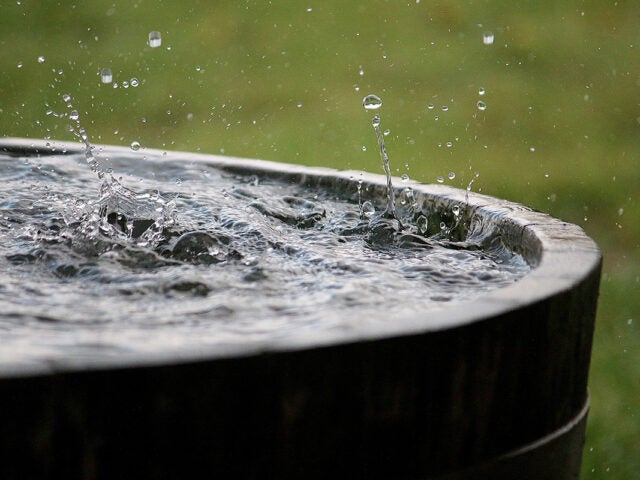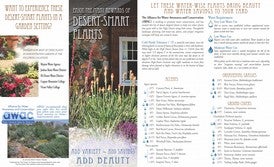Landscaping Resources
Easy Ways to Save Water Outdoors
There are many ways to save on water (which means saving on money, too!). Check out the following resources that will help you to save water consumption.
Around the Yard
Learn simple habits to help reduce water use outside your home.
Use Water-wise Plants
Check with your local water agency on the best plants for your area; it is best to use water-wise, California-native plants when possible.
Use a Broom to Clean Outdoor Areas
Using a broom to clean outdoor areas can save 6 gallons every minute.
Install Drip Irrigation & Add a Smart Controller
Installing a drip irrigation system and a smart controller can save 15 gallons each time you water.
Avoid overwatering and irrigation runoff. Shorter, more frequent watering is usually best.
Adjust sprinklers to water plants only — not sidewalks, driveways, patios, or streets. Maintain your sprinkler heads and valves to avoid creating hazards on sidewalks and streets!
Use Drought-resistant Trees, Plants
Using drought-resistant and native plants and trees can save 30–60 gallons per 1000 sq. ft. each time. They require less water and are often easier to maintain. Group plants with similar watering needs.
Reimagine Your Yard
Feed your vegetables and fruits water first because they feed you! Water-wise plants and shade trees use little or no water once established. Thirsty plants such as lawn and container plants are the lowest priority. Set Mower Blades to three inches. Adjusting the hight to 3″ encourages deeper roots and saves 16–50 gallons per day.
Limit turf because grass is the biggest water user of all – turf can use more water than your whole family every day!
Use Mulch
Using mulch can save 20–30 gallons of water per 1000 sq. ft. each time you water.
Use a 2-3 inch thick layer of mulch such as rock, bark, gravel, wood chips, or compost around trees and plants.
Adjust Sprinkler Heads & Fix Leaks
Save 12–15 gallons each time you water. Fact: a leak about as small as the tip of a ballpoint pen can waste about 6,300 gallons of water per month!
Change Watering Hours
During warmer months, water at night or early morning to avoid evaporation. Don’t forget to change those watering hours during freezing temperatures.
Maintain Your Pool
Equip swimming pools, fountains, and ponds with recirculating pumps. Use a pool cover and check for leaks. Uncovered pools can lose up to 100 gallons per day to evaporation!
Month-by-Month Water Wise Landscape Gardening and Watering Schedule
January
Description
Frost is likely on dry, windless, clear nights this month.
Watering Schedule
9:00 am to 3:00 pm
Ways to Save
- To prevent ice from forming on the driveway and sidewalks, water only during the warm time of day.
- Wrap irrigation valves and pipes to protect from freezing
- Turn off irrigation timers if it rains
- Apply mulch around plants to retain water and soil, and feed nutrients into the soil with each rain
- Prune roses and summer-blooming deciduous fruit trees
- Don’t prune frost-damaged plants until spring growth appears
- Plant bare-root trees and shrubs now through early March
- Mulch around plants and under downspouts with bark, compost, or gravel
- Keep plants watered to help prevent frost damage
February
Description
Good month to control winter weeds before they flower.
Watering Schedule
9:00 am to 3:00 pm
Ways to Save
- Avoid running sprinklers on windy days – you’ll think your plants have received water, but most moisture may have gone into the air.
- Plant ground covers, bulbs, low-water-use plants, and natives if you missed the fall planting season
- Plant bare-root trees and shrubs through early March
- Prune evergreens now, but not later in spring or summer
- Prune the rest of your summer-blooming deciduous fruits and nut trees, roses, and dormant shrubs
- Fertilize perennials and trees with slow-release plant food (most natives and drought-adapted plants don’t need fertilizer)
- Water trees deeply to prepare for spring growth surge (deep roots protect trees from blowing over)
March
Description
Warm, mild weather this month prompts rapid growth of plants, as well as insect pests.
Watering Schedule
9:00 am to 3:00 pm
Ways to Save
- Replace batteries in your irrigation clocks when Daylight Savings Time starts.
- Plant perennials as early as possible this month if you missed the fall planting season
- Transplant Joshua trees and Yuccas from March to mid-April
- Teach plants to grow deeply for moisture. In spring, for average soils, water deeply only every 2-3 weeks
- Check aphids on new growth, wash off with a strong jet of water
- Get rid of weeds while they are small, especially before they reseed
April
Description
Color season is reaching its peak – spend time outside enjoying it!
Watering Schedule
9:00 am to 3:00 pm
Ways to Save
- Test run your irrigation system to check for leaks and spray heads that are broken or out of adjustment.
- Reset irrigation schedules and increase the watering time as temperatures rise
- Work compost or soil amendments into planting beds to improve moisture retention as summer approaches
- Plant cold tender perennials, preferably in pots so winter protection is easier
- Keep mulch on the soil – especially with organic matter such as leaves, bark, or chipped wood – to temper the drying and heating effect of the sun; irrigation will be more effective with less frequency and quantity
- Continue pulling weeds before they form seed heads (if weeds are brown, you waited too long); you’ll have fewer weed problems later
May (Water Awareness Month)
Description
Rising temperatures cause changes in plants.
Watering Schedule
Before 9:00 am – After 6:00 pm
Ways to Save
- Due to warmer weather, it is best to water during the early morning and late evening hours to reduce evaporation.
- Change watering schedule from mid-day to early morning or evening as the weather heats up to minimize loss through evaporation
- Maintain a good mulch of organic matter covering garden soil throughout the summer to hold in moisture
- Remove (deadhead) spent flowers unless you want to collect seeds to stimulate repeat blooming
June
Description
Good season to plant or transplant palms or cacti
Watering Schedule
Before 9:00 am – After 6:00 pm
Ways to Save
- Take a few minutes each week to check your sprinklers for water run-off. You’ll save water and save money on your water bill.
- Prune fast-growing trees like mesquite, palo verde, and acacias to reduce the chances of wind damage; don’t remove more than 20 percent of a plant’s foliage at any one time to avoid stress or sunburn on the trunk and branches
- Keep adding to mulches throughout the summer to conserve water, keep roots cool, and deter weeds. Water well before applying the mulch (or through an opening in the mulch)
- Continue to deadhead spent flowers for a longer bloom cycle
July (Irrigation Efficiency Month)
Description
Smart water-wise practices pay off now: Climate-adapted plants + mulch + deep watering = Less water use
Watering Schedule
Before 9:00 am – After 6:00 pm
Ways to Save
- If water runs off your lawn and flows into the gutter, allow it time to soak into the soil; apply water for only 3 to 4 minutes – wait an hour, then repeat.
- Check irrigation emitters, valves, and lines for clogs, leaks, and breaks
- Flush the lines by removing end caps with your water system on; sand or deposits that build up in lines can clog emitters
- If you water by hand, leave a drip hose at the root of trees and shrubs to deeply soak soil once a month; set a timer to remind you to move the hose to the next plant
- Keep adding to mulches as they decompose to conserve water, keep roots cool, and reduce the frequency of watering
- Encourage repeat blooming by planting or cutting back annuals, perennials, and shrubs
August
Description
Good month to sit back and enjoy your garden, few chores besides watering and grooming
Watering Schedule
Before 9:00 am – After 6:00 pm
Ways to Save
- Reduce your water bill during peak temperatures by cutting just one watering day per week out of your daily lawn sprinkler schedule
- Walk irrigation lines to check for clogs, leaks, and breaks
- Deadhead spent flowers, trim off dead flowering stems (save seeds for replanting)
- Continue deep-watering trees and shrubs once a month
- Keep adding to mulches to conserve water, keep soil and roots cool, and reduce the frequency of watering
September
Description
Mid-September to mid-October starts the most important planting season of the year
Watering Schedule
Before 9:00 am – After 6:00 pm
Ways to Save
- Water – are you using it wisely? Find out today by contacting your local water district for assistance and information.
- Plant native and drought-tolerant plants; warm soil helps new plants develop deep roots before summer, reducing water needs during the new plants’ entire two- to three-year establishment period
- Fall opportunity to transplant Joshua trees and Yucca trees from late September to October
- Reduce water to cactus and succulents to prepare them for winter rest and protect against frost damage
- Protect against wildfire as Santa Ana winds start; prune dead limbs, clean away brush, and clean leaves from gutters
October
Description
Take advantage of the fall planting season to develop summer-ready plants.
Watering Schedule
Before 9:00 am – After 6:00 pm
Ways to Save
- As the weather cools down, grass, shrubs, and trees need less water. Reduce the amount of time and the number of days per week that you water.
- Continue to plant native, drought-tolerant, and other perennial plants and trees; fall plantings develop deep roots while soils are still warm
- Adjust irrigation timers as nights get longer and cooler. Simply making monthly changes to your irrigation schedule can save more water and money than any other thing you can do
- Fall annuals abound in nurseries, but are mostly high water use; consider using them only near entries, on patios, and in containers. Plant perennials and bulbs for lower maintenance and water use
November
Description
Last chance for fall planting season while roots are still active.
Watering Schedule
9:00 am to 6:00 pm
Ways to Save
- To prevent damage to your sprinkler system during freezing temperatures, the water supply should be turned off.
- You may continue planting this month even with cooler temperatures, but plants will establish roots more slowly than earlier in fall. Finish planting California natives
- Plant seeds for spring and summer blooms; choose a mix of western wildflowers with annuals and perennials for long-lasting color
- Irrigate frequently during Santa Ana winds, which pull moisture from both plants and soil
- Give one last deep watering to deciduous trees and grapevines, but discontinue feeding to harden them off for cold weather
- Irrigate fall-planted trees and bushes deeply once or twice this month to ensure good root formation prior to dormancy
December
Description
Winter begins and plant growth is on hold until February
Watering Schedule
9:00 am to 6:00 pm
Ways to Save
- If pipes freeze, warm them gradually with a hairdryer or space heater. Pipes that warm too fast can break.
- Prune to shape evergreens like arborvitae, juniper, pines, and cypress – and save trimmings for holiday decorations
- Prune dense trees to avoid wind damage; make sure young trees are well-staked
- For overnight protection when frost threatens, cover delicate plants with large cardboard boxes, old sheets, or tarps
- Consider setting irrigation timers to “off”, and manually water in response to our irregular winter weather, based on winds, rain, or snow. Using the manual mode on your controller in winter can save precious water




